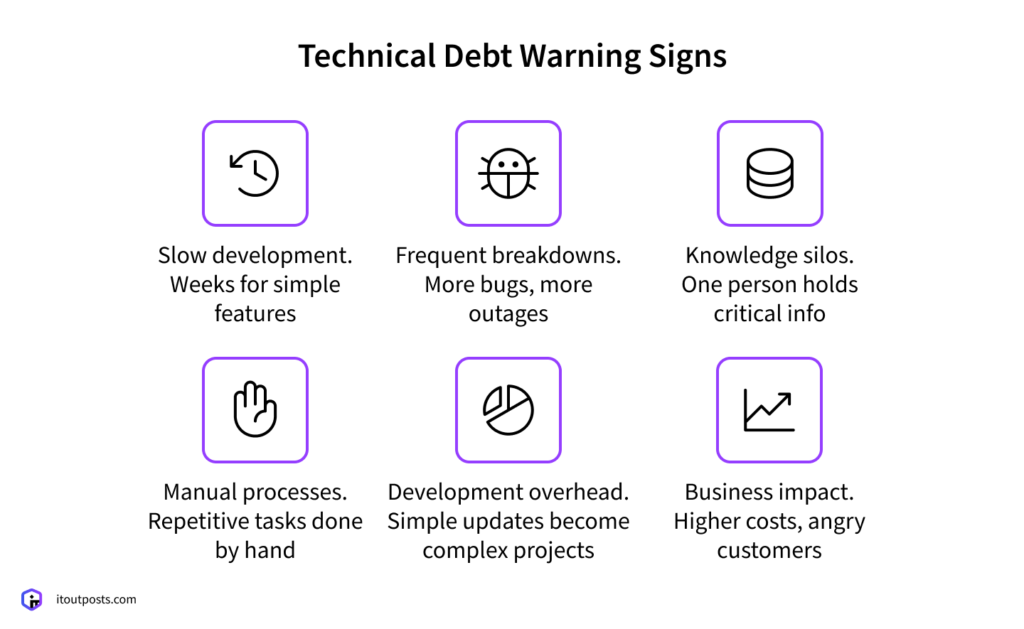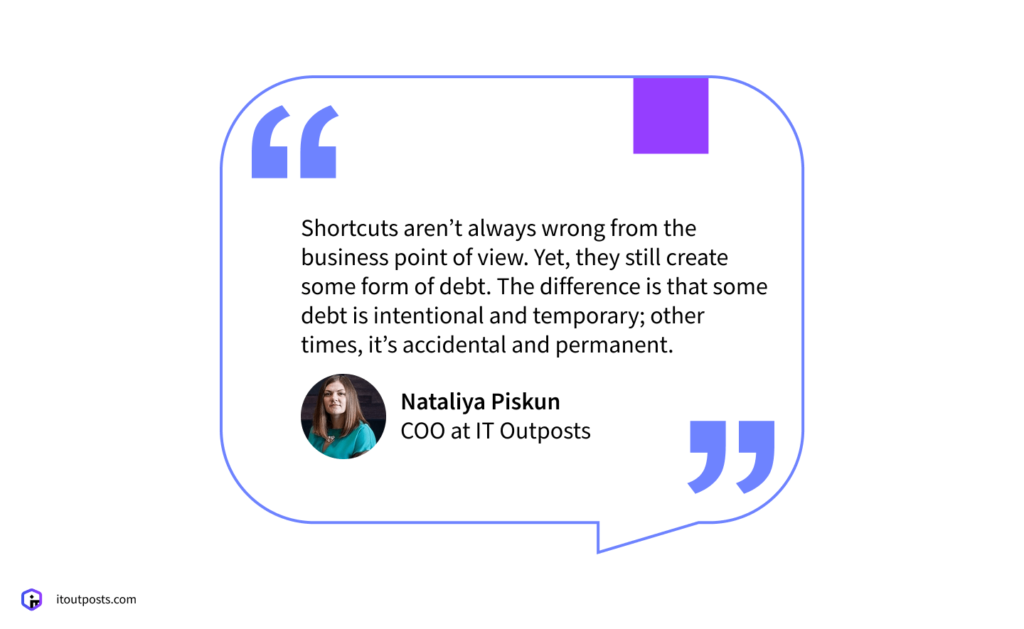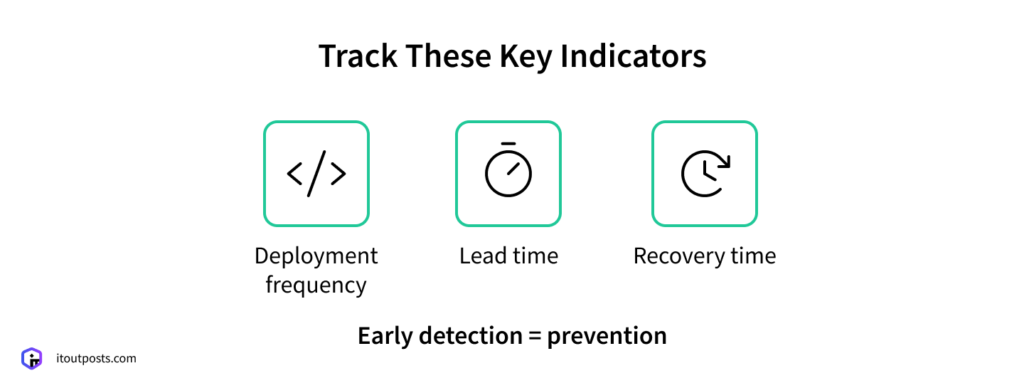Contents
Technical debt often doesn’t show clear signs at first. It quietly builds up in your systems until it reaches a point where it starts holding back your growth.
The key to managing it is understanding how technical debt develops. Once you’re familiar with the signs to watch for, you can catch it early and fix it before it leads to bigger, more costly problems.
What Is Technical Debt?
Technical debt is the hidden cost that comes from making suboptimal decisions when building software and managing infrastructure. It represents the gap between how your system should ideally work and how it’s actually functioning right now.
Many organizations have that one script. A few people know how it works, and nobody dares to touch it. But somehow, the entire system depends on it. That’s technical debt in its purest form. Every promise to “update that later” and every band-aid solution that’s temporarily patched but never properly resolved adds to it.
Sometimes, teams don’t even realize they’re accumulating this debt. They’re busy pushing out new features and improvements, but the system slowly becomes harder to handle. Small updates start taking days, and fixing one bug can end up breaking the entire service.
Eventually, this accumulation reaches a breaking point. And when this happens, it can start to seriously impact the business’s performance and growth.
Signs of Technical Debt
Your technical debt has officially taken over when these signs appear:
- The development pace drops. Your team used to ship features quickly. Now, basic tasks may take even weeks. Developers have to waste time untangling existing code before adding new functionality.
- Systems keep breaking. Outages happen more often than before, and every new release seems to bring new bugs. Support staff ends up spending most of their time apologizing for unavailable services.
- Only one person knows how systems work. Important knowledge, like server configurations, deployment procedures, and backup processes, isn’t documented and only lives in individual heads. This makes vacations and absences risky, as the rest of the team becomes helpless when problems arise.
- Too many manual steps. Technical debt accumulates when processes rely heavily on human intervention. Deployment involves manual setup, and testing means clicking through the same screens repeatedly instead of using automated tools.
- Simple changes turn into big projects. Tweaking a minor feature or fixing a small bug often requires multiple team members and a lot of testing. Sometimes, even simple updates involve discussions about architecture, and estimates become unpredictable.

As a result, technical debt hits your bottom line. Customers get frustrated when systems crash during busy times, which can lead to lost revenue, while sales teams promise features that engineering can’t deliver on time.
On top of that, technical debt increases operational costs. You need more developers just to keep fragile systems running and support teams to handle more customer requests, all while infrastructure costs rise because inefficient code demands more resources.
Is It Possible to Avoid Technical Debt?
The truth is, you can’t completely get rid of tech debt. It’s like trying to keep a house spotless while people live in it.
A software product is a living organism that constantly evolves. Someone initially builds the architecture and establishes basic processes. They automate systems and write documentation. But the project keeps developing and moving forward. Technologies change, new functionality features double in number, traffic increases.
Plus, the project needs to update from all sides as it grows, both in code complexity and infrastructure requirements. If your code updates, then everything under the hood should update with regular frequency, too. Otherwise, eventually, systems might become too difficult to manage.
When development decides to update something on their side, they should consult with DevOps experts whether this change brings consequences or not from the operational angle. Because issues may surface somewhere. Either you won’t be able to actively push code changes, or you’ll get a system load that causes failures.
Business priorities create another layer of complexity. Sometimes, moving quickly is more important than having a perfect system. For example, a startup trying to find its footing in the market may not be able to afford to build a well-thought-out architecture from the beginning. Or, if a company faces intense competition, it might choose quick fixes over long-term solutions.

So, How Do You Avoid It?
The question isn’t whether you can avoid technical debt. The question is whether you can handle it on time. And hygiene measures do exist to keep it manageable.
Describe Your Infrastructure as Code
Instead of manually setting up servers and systems by clicking buttons, define your entire infrastructure using code files. This approach, known as infrastructure as code (IaC), helps make sure your setups are consistent and repeatable, and human errors are reduced.
Manual setup creates problems because people make different choices. These small differences add up until your systems work differently from each other.
But with IaC, your processes will follow the exact same steps every time. This means your testing environment will match your live system, eliminating bugs that only happen when customers start using your product.
Written instructions also create a permanent record. You can see exactly how your systems are built and who made a particular change. If one service breaks, it’s easy to roll back to an earlier, working version.
Write Documentation
Relying solely on people’s memories for important information can put your business at risk. If someone leaves or goes on vacation, nobody might know how to handle key processes.
That’s why having clear documentation is so critical. It helps new team members get up to speed faster and keeps important information safe, even if people come and go.
Run Automated Testing
Without automated testing, every update becomes a bit of a gamble. Sometimes fixing one part can accidentally break another, and these are only obvious when someone notices a bug or a customer complains. Furthermore, the larger your software becomes, the more likely these accidents are to happen.
With automated testing, humans don’t have to manually check if a service works after each change. Computers can run thousands of checks automatically and do it consistently every time.
Monitor Technical Health Metrics
We also highly recommend tracking technical metrics to understand the software’s condition. The following metrics provide early warning signals of a tech debt:
- Deployment frequency shows how smoothly your team can release new features. Healthy systems allow frequent, easy releases. Unhealthy systems, in contrast, make every release a stressful event that requires careful planning and multiple people involved.
- Lead time measures how long ideas take to reach customers. This includes everything from initial concept to a working feature in the customer’s hands. Long lead times often indicate technical problems that slow down development.
- Recovery time reveals how quickly you can fix problems when they occur. Systems weighed down with technical debt tend to take longer to diagnose and repair. Clean and organized systems can be fixed rapidly when issues come up.

Allocate Refactoring Time
Refactoring means making improvements to existing code without changing how it behaves for the users. This could involve cleaning up messy parts, updating old components, or making complex areas simpler and easier to understand.
Many companies set aside dedicated time for maintenance work in every development cycle. They don’t wait for perfect moments that may never come but plan regular improvements alongside developing new features, recognizing that both are key to long-term success.
Break Free from Technical Debt
Whether your technical debt is conscious or accidental, it deserves attention. It’s a common challenge in software development and delivery, but a DevOps approach can actually help address it.
The teamwork and automation that characterize DevOps create natural ways to better manage technical debt.
Whether you’re struggling with existing technical debt that seems impossible to untangle or starting fresh with the goal of preventing debt accumulation, IT Outposts has a solution for you.
Meet AMIX, our ready-to-use infrastructure. It’s built from real experience, with the best DevOps practices and more than 50 successful projects behind us.
We’ve combined what works the most effectively (and cost-effectively) into one comprehensive system.
The platform offers 20+ professionally configured tools. Full documentation is included.
If you’re ready to build reliable, long-lasting systems, contact us today and discover how AMIX can help eliminate technical debt from your software delivery process.

I am an IT professional with over 10 years of experience. My career trajectory is closely tied to strategic business development, sales expansion, and the structuring of marketing strategies.
Throughout my journey, I have successfully executed and applied numerous strategic approaches that have driven business growth and fortified competitive positions. An integral part of my experience lies in effective business process management, which, in turn, facilitated the adept coordination of cross-functional teams and the attainment of remarkable outcomes.
I take pride in my contributions to the IT sector’s advancement and look forward to exchanging experiences and ideas with professionals who share my passion for innovation and success.